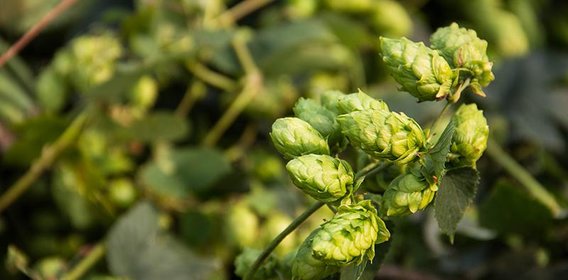Research Conducted by:
The Orshinsky Lab:
Angela Orshinsky, Assistant Professor
Josh Havill, M.S. Student
Victoria Hoeppner, UROP Student
Conducting on-site research trials with Minnesota hops producers
As the microbrewery industry in the state of Minnesota continues to expand each year, brewers are looking to hop producers near home to provide sustainable and high-quality hops. In order to meet this growing demand, Angela Orshinsky, assistant professor in the Department of Plant Pathology, and her research team are working with hop producers throughout the state to provide answers to the many hops management questions that past research has not yet answered for local producers.

“There are a lot of unanswered questions with hops in Minnesota and other areas in the Midwest where hops have not been traditionally grown,” says Eric Sannerud CEO of Mighty Axe Hops (Currently of Business), a hops growing farm in Ham Lake, MN started by Sannerud and fellow CFANS alumnus Ben Boo. Mighty Axe Hops is one of the many locations in Minnesota where Orshinsky’s team is conducting on-site research trials, in order to provide growers the research-based information they need to be able to successfully grow local hops.
Filling the Local Knowledge Gap
"There’s an ever present gap in knowledge of how to grow hops in areas where they have not been traditionally grown,” says Josh Havill, M.S. student whose research project focuses on hop disease diagnosis and management.
This gap exists since traditionally hops production has been highest in the Pacific Northwest as well as in areas of Michigan. In fact, hops have not been grown on a commercial scale in Minnesota since the early 1900’s when both hop downy mildew and Prohibition forced a halt in production. As a result of this growers have been left primarily with management recommendations based on data collected from a drastically different growing environment. By carrying out on-site research trials, Orshinsky’s team can provide region-specific management recommendations, so growers can make the best decisions for their operation.

“The benefits of doing on-site grower trials is that this is a real-world condition. This is not something you set up in an isolated spot or in a greenhouse. The growers get to go out and see how they can implement agronomic practices to properly manage their hops,” says Orshinsky.
Properly Fertilizing a Heavy Feeder
Hops plants can grow anywhere from 12 to 20 feet in a span of about three months during the Minnesota growing season. As a result of this the plants require a lot of care and a proper fertilization regimen in order to maintain proper growth. One portion of Orshinsky’s research project focuses on nitrogen fertilizer amendments and how the timing of those applications affect yield, cone quality, and alpha acid content.
“This project in particular was the result of my impression that we really don’t have any nitrogen recommendations for growing hops in Minnesota,” says Orshinsky.
The project focuses on evaluating conventional and organic nitrogen fertilizers options, and when are the most effective times for growers to be applying these fertilizers. Fertilizer sources are also being assessed to see if they influence disease progression, since anecdotal evidence has shown that fertility sources may influence the diseases present in hop yards.
Protecting from Disease
Throughout the Midwest, many hops diseases are prevalent because of the amount of rain occurring each year and cold winters promote diseases such as downy mildew (Pseudoperonospora humuli). Growers are constantly battling with diseases that can devastate yields and the overall quality of the cones.
“Disease management throughout the season that’s just what you have to do. What we’ve created behind me is an enormous perennial monoculture, so all of the diseases that like hops are starting to figure out that we have hops here,” says Sannerud.
Orshinsky’s team is working with growers to educate them on how to identify and manage the diseases they face in their yards effectively and sustainably through various agronomic practices. One of the long-term goals of this project is to also develop hops varieties that are resistant to disease, and currently the team is assessing wild hops varieties to see if there is resistance to downy mildew, the state’s most prevalent disease.
“Developing these cultivars would be a great contribution to the reduction of disease especially in a sustainable system where you’re trying to reduce fungicide inputs,” says Orshinsky.
Growing the Industry
Moving forward Orshinsky’s team hopes to provide a solid foundation of information for hops growers as the industry continues to grow and evolve throughout the state. In order to do this the research relies heavily on the collaboration between the hops community and University of Minnesota research.
“In general I’m always asking growers what I can do for them and I’m always interested in hearing back from them what they need to see from University research so we can provide them with the information that they’re looking for,” says Orshinsky. The research will continue to search for answers to the questions that current research does not yet speak to in order to help provide growers the necessary skills to be able to grow hops in an environmentally sustainable and profitable manner.
“The hops industry has a lot of room to grow and a critical support for that industry getting to where we need it to be is University research,” says Sannerud.
